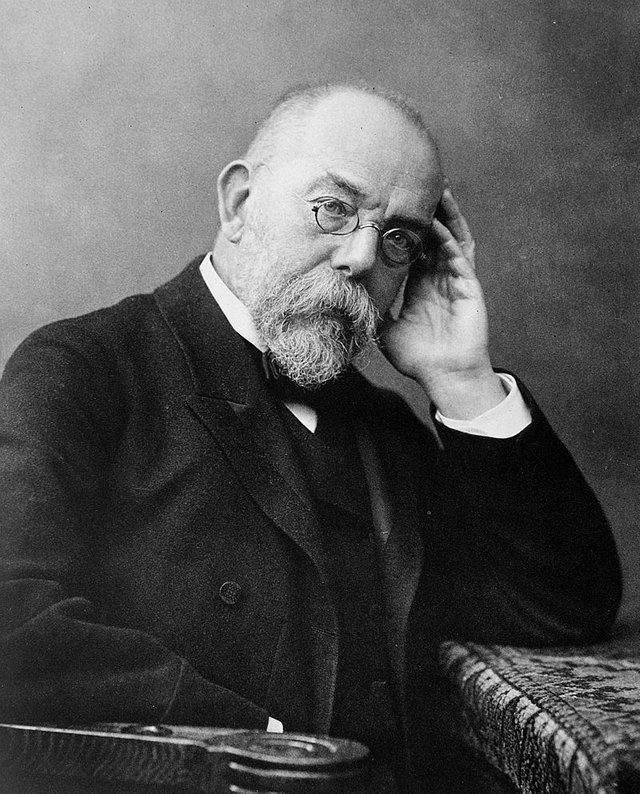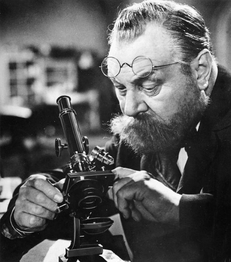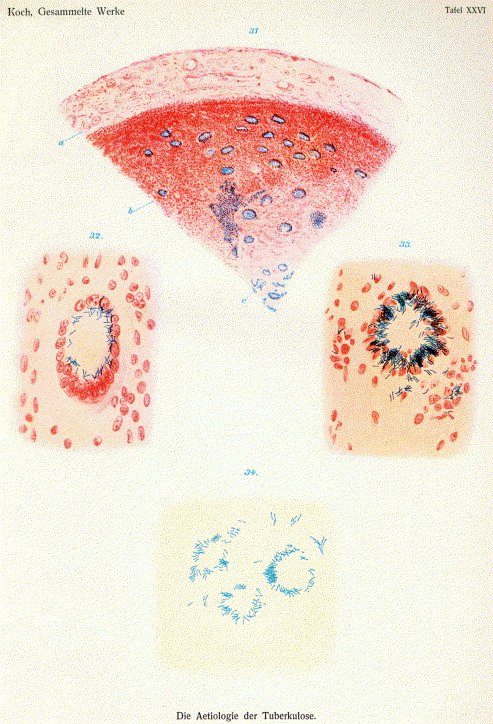Robert Koch (December 11, 1843 in Clausthal, Germany - May 27, 1910 in Baden-Baden, Germany) is a German physician known for his discovery of the bacterium responsible for tuberculosis that bears his name: "Bacillus of Koch". The work he will do to discover it will earn him the Nobel Prize in Physiology or Medicine of 19051. It is one of the foreverators of bacteriology.

Son of an engineer in the mining industry, Hermann Koch, who is steward of the mines Claustahl Zellerfeld, and Mathilde Juliette Henriette Biewend, daughter of an iron mining inspector, Robert - christened Heinrich Hermann Robert Koch - is the third child of a family that will have thirteen (eleven still deceased). With two old aunts, an uncle and the domestic service, the household can count up to nineteen people. At the age of four, he learns alone to decipher a few words in the newspapers; at the age of five, he enters primary school. In 1851, at the age of eight, he joined the Gymnasium.
The maternal uncle, Eduard Biewend, takes young Robert on an excursion to observe nature; he also introduces him to photography (at a time when every photographer must prepare his solutions and his plates). In high school, Robert is a studious student, with facilities in mathematics and natural sciences. In 1862, Robert passes his Abitur. While his father would see him emigrate to the United States as his two older brothers, the young Robert, loving Emmy Fraatz, went the same year to Göttingen, with the intention of quickly forming the profession of professor . During his second semester of study, he reoriented his training towards that of doctor. The University of Göttingen is renowned. Koch studied anatomy with Jacob Henle, a defender since 1840 of the microbial theory of contagious diseases. He also studied the clinic with Karl Ewald Hasse, psychology with Rudolf Hermann Lotze, physics with Wilhelm Eduard Weber and chemistry with Friedrich Wöhler. The physiologist Georg Meissner introduces him to animal experimentation. After graduating as a doctor in January 1866, Koch spent three months in Berlin attending the Virchow lectures. On March 12, 1866 he obtained his license as a doctor in Hanover. In 1867, after a position of deputy physician at the Hamburg Hospital, he found a post at Langenhagen in an institution for mentally retarded children. In this same city he also opens a cabinet of generalist. On July 16, 1867 he married Emmy Adolfine Josephine Fraats, the daughter of a pastor of the Evangelical Church of Clausthal. In Langenhagen he began his microscopy work and his naturalistic studies; his wife, Emmy, helps him in the ranking of the samples taken. Two years after settling in Langenhagen, following an administrative reorganization of the institution, Koch has to look for a new job. In June 1868 he tried to open a cabinet in Braetz; he tries to Niemegk, near Potsdam, where his wife and their young daughter Gertrud (born September 6, 1868) join him. His professional and financial situation is difficult.

Finally, Koch moved to Rakwitz in the province of Posen, where he managed to build a loyal clientele. When the war of 1870 broke out, Koch, myopic, was exempted from active service; however, he volunteers for the Army Health Service. He will be assigned to Neufchateau and Orleans where he will have to deal with typhoid fever and war wounds. Demobilized before the end of the war, he returned to Rakwitz. In January 1872, he passed the examination of Kreisphysikus (cantonal doctor). A post freeing himself at Wollstein in Silesia, he moved there in April 1872. He stayed until 1880 in Wollstein where he was responsible for public health at the local level; it is there that he makes his first discoveries which will make him famous.
The reading of Coze and Feltz's report on streptococci prompted Koch to undertake his bacteriological research on contagious diseases2.
In 1876, Ferdinand Julius Cohn published the works of Koch, which immediately earned him a great reputation.
In 1877 he published a text on microphotography.
In 1880 he was appointed professor at the Reichs-Gesundheitsamt Berlin.
Between 1884 and 1885 he was commissioner of the imperial office for health.
In 1885, Robert Koch obtained the chair of hygiene at the University of Berlin.
In 1890 he divorced.
In 1891 is created for him the Institute of infectious diseases, which he takes the direction.
In September 1893, Koch remarried Hedwig Freiberg, a 17-year-old student and amateur actress.
Robert Koch received the Nobel Prize in Physiology or Medicine in 1905 "for his investigations and discoveries related to tuberculosis". He became a foreign member of the Royal Society on March 4, 1897.
He died on May 27, 1910 of a heart attack. Incinerated according to his wishes, his ashes are transported to Berlin.
Koch presents his discovery of the bacillus at the Institute of Physiology Emil du Bois-Reymond March 24, 1882. At the end of the presentation, scientists amazed, do not issue any question; Virchow, known for his opposition to the theory of germs, leaves the room without saying a word. The same evening, the telegraph carries the news all over the world. This presentation, which is published on the following 10th of April, 4 is followed by three articles: Über die Ätiologie der Tuberkulose (in the summer of 1882, at the Congress of Internal Medicine, Wiesbaden), Kritische Besprechung der gegen die Bedeutung der Tuberkelbazillen gerichteten Publikationen in 1883, and finally in 1884 the monumental Die Ätiologie der Tuberkulose which offers a detailed presentation of his works.
Having adopted an understanding of illness similar to that previously developed by Laennec, Bayle, Villemin and Cohnheim, Koch and the team he leads at Reichsgesundheitsamt isolate the bacillus in just eight months. Because of its small size and the inability of methylene blue to color, the bacillus has previously escaped the attention of researchers (the bacillus is observable however fresh, Ehrlich who has already observed these He thinks he can identify with crystals: thanks to the double-coloring technique that he develops, Koch is able to identify it, and as Albert Neisser did in 1879 for the leprosy bacillus, Koch firstly, the 24 hour smear slides in the methylene blue alkalinized with potassium hydroxide and then treated with vesuvine: the bacilli are blue on a background of cellular elements and brown microbes.5 (At the same time, or a little before, Paul Clemens von Baumgarten also identifies the bacterium.6 By finding the bacillus in clinical forms then considered as separate nosographic entities, Koch contributes to unifying the concept of tuberculosis (Koch can not, however, prove tuberculous nature of scrofula). Although he has pointed out in previous works the importance of the publication of photomicrographs, supposedly more objective and impartial than the drawings, Koch does not publish photographs of the bacillus but simply drawings. In his 1884 article, Koch mentions the presence of spores in bacilli7.
While in 1882 Koch avoided expressing a too decided opinion as to the respective weight of bacillus and heredity, in 1884 he was more categorical, describing heredity as a marginal factor.
Koch used the rabbit iris inoculation method published in 1879 by Carl Julius Salomonsen and Cohnheim.
In 1882, he isolated the bacillus from tuberculosis by developing an in vitro culture method and reproducing the disease in animals with the cultivated strain, proving that the germ is responsible for the disease and invalidating Virchow's cell theory. . This germ owes its name to him, bacillus of Koch. Its scientific name is Mycobacterium tuberculosis. This discovery leads to the use of hygiene measures to combat the transmission of the disease. Notably because tuberculosis is not immunizing, Koch does not believe in the possibility of a vaccine; he is therefore seeking a treatment which he thinks he finds in a product extracted from the bacillus he is developing, the tuberculin, which he announces in 1890: it is a failure. He persevered, presenting in 1897 a second version of tuberculin ... which proved as ineffective and dangerous - even fatal - as the first one9. However, tuberculin will be used to diagnose the disease.

Source: http://la-loupe.over-blog.net/article-koch-robert-82188459.html
Not indicating that the content you copy/paste is not your original work could be seen as plagiarism.
Some tips to share content and add value:
Repeated plagiarized posts are considered spam. Spam is discouraged by the community, and may result in action from the cheetah bot.
Creative Commons: If you are posting content under a Creative Commons license, please attribute and link according to the specific license. If you are posting content under CC0 or Public Domain please consider noting that at the end of your post.
If you are actually the original author, please do reply to let us know!
Thank You!
More Info: Abuse Guide - 2017.
Downvoting a post can decrease pending rewards and make it less visible. Common reasons:
Submit
up
Downvoting a post can decrease pending rewards and make it less visible. Common reasons:
Submit
up
Downvoting a post can decrease pending rewards and make it less visible. Common reasons:
Submit
up
Downvoting a post can decrease pending rewards and make it less visible. Common reasons:
Submit